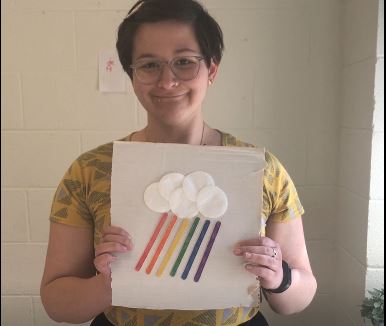
An essay by JCC PJ Library Coordinator Amalya Stone
I’m not going to sugar-coat it, it’s tough times out there, y’all. The state of things right now is unprecedented, uncertain, and jarring for just about everyone in a multitude of different ways. And amidst all this chaos, it’s easy to feel lost and overwhelmed, especially when it comes to what we should say to our kids.
While there are about a zillion things going on in the world right now, I want this article to focus on just one: Talking to your kids about race. When a parent wants to have “The Talk,” one’s mind usually goes to a parent teaching their child about sex, but recently the concept of “The Talk” has shifted context to be about teaching our children about race. Over the past few days, I have been attending several webinars, reading articles, and listening to news sources to compile some tips and tricks on how to have “The (Race) Talk” with your child.
According to NPR, there are five steps to having a constructive conversation about race with your child. These steps are appropriate for children as young as three or four years old. It is important to start having conversations that early, so children can scaffold knowledge as they grow older.
One: Kids are not colorblind, so do not be “color-silent.” Acknowledge that people have different skin colors, hair textures, and physical attributes, and accept such statements from your child as well. Neutral statements such as, “That person has brown skin,” are appropriate and acceptable for both parents and students to make. This helps children notice that people may look different from them, but there is nothing inherently better or worse in that difference.
Two: Build positive awareness of diversity and identity. Help children learn about different cultures, national origins, and ethnicities, and celebrate diversity.
Three: Validate feelings when applicable. Children may be picking up on different vibes such as fear, hurt, or they may even be experiencing prejudice based on their race. Their feelings and emotions surrounding this are valid, and deserve to be acknowledged. Use it as an opportunity to say, “I understand why you would feel that way. Let’s go learn more about it together,” or “Let’s bring a book about it to school and read it to your class.”
Four: Don’t shy away from scary historical subjects if the child brings them up. In the NPR recording, a woman said her four-year-old son had asked, “If we came from Africa originally and it was so great, why are we living in America?” If a child asks a question that might lead to a discussion of an uncomfortable historical event, remember these steps:
- State the basic facts, and state them in age-appropriate terms.
- Give reassurance (it was a long time ago, it can’t happen to you)
- Give a sense of hope (highlight examples of resistance and allyship)
- Offer an opportunity for further exploration (“Let’s read a book about this,” or “Let’s learn more about this together.”)
Five: Model the behavior. Set an example for your child of how you want them to behave surrounding the conversation of race. Expose them to a wider or more diverse range of media. Push back against stereotypes they might have heard. And refuse to accept racist jokes or comments even when it may be more comfortable to ignore them and remain silent.
These concepts will create crucial and fundamental building blocks upon which a parent can scaffold learning. The concept of race can be introduced as early as age three, and then learning more about how race fits into American society (things like racial injustice and inequality) can be introduced once children reach school age.
Another popular question that’s being asked lately is, “How do I bring it up?” Many parents may be feeling uncomfortable around the subject because they want to address it with their child but they’re not sure how to start the conversation. The easiest way to do this is to engage the child by asking what they know or have heard about a current situation. This is most appropriate for school-aged children, but it can be used for younger children as well. Ask open-ended questions such as, “Have your friends at school been talking about x y and z?” or, “I was watching something on the news and I wonder what you think about it?”
For older children, this conversation can go deeper. This can be an opportunity to teach them to be critical consumers (teaching them about things like clickbait, and teaching them that not every news source may be reliable or unbiased). Gauge their reactions, address their concerns, and do your best to provide further context and explanation to what they’re seeing or hearing.
What about these children who don’t want to engage at all? Parents are asking themselves, “My child hasn’t talked about it at all; is that normal?” The answer is “yes.” It’s hard to walk a fine line between “I want to bring this up so my child is informed,” and “now I’m just lecturing at them, which will make them tune me out.” Striking a balance is key to educating children on the subject. This is where those open-ended questions come in like, “What have you been hearing? Tell me what your experience has been like.” Give the child an opportunity to talk about themselves, and then address their personal experience by giving a wider context. If a child is reluctant to engage, validate that by saying you understand, but also acknowledge that this discussion or learning opportunity is part of the process of building a better world.
My concluding piece of advice is that you show humility. There are two different ways that this can come into play.
One: So many people are letting their fear of “messing up” stop them from having the conversation in the first place. It is always okay to circle back to an early conversation and say, “You know, I don’t think I explained that quite right,” or “I don’t really like the way I explained that yesterday, let me try again.” In fact, doing so will demonstrate that you make mistakes but aren’t afraid to double back to try to fix them.
Two: Speaking of mistakes, don’t be afraid to acknowledge personal anecdotes where you might have “missed the mark” by saying or doing the wrong thing. Share these openly with your child and point out that you didn’t take the right action during that time, but now you would react or behave differently. Modeling humility is going to show your child that mistakes will happen, but there are always opportunities to try to repair them for that situation and/or in the future.
Overall, it’s a chaotic time. We may be feeling a broad spectrum of emotions: hesitation to bring up the subject, fear that we will mess up, confusion over our children’s reactions. The most important step is that you take one in the first place. Our job as parents, as educators, as adults in the lives of children is not to convince the children that our thoughts and views are “right.” Our job is to model the values we want them to exemplify.
The tips, resources, and strategies expressed in this article were sourced from the following places:
-Talking Race with Young Children from NPR: https://www.npr.org/2019/04/24/716700866/talking-race-with-young-children
-Helping Kids Process Violence, Trauma, and Race in a World of Nonstop News from CommonSense Media, a live panel. For more topics from CommonSense, click here: https://www.commonsensemedia.org/
-“How Do I Make Sure I’m not Raising the Next Amy Cooper?” a live panel presented by Embrace Race. For more topics from Embrace Race, click here: https://www.embracerace.org/





